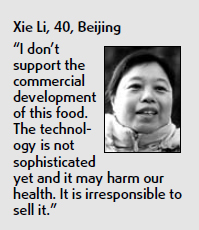Government and Policy
China turns to GM rice for food supply
By Shan Juan and Jin Zhu (China Daily)
Updated: 2010-02-04 06:58
 |
Large Medium Small |
Commercial planting expected in 3-5 years, scientist says
The government is expected to approve commercial planting of genetically modified (GM) rice in three to five years as a major effort to raise food supply.
|
||||
In November, the ministry issued bio-safety certificates to strains of pest-resistant GM rice and corn.
But the strains need registration and production trials before commercial output can begin, which may take three to five years, Huang told China Daily.
"The issuing of bio-safety certificates has great implications as it is the first time a major grain producer is endorsing the use of GM technology in a food staple," said Xue Dayuan, professor of biotechnology at Minzu University of China.
The government has set a target of increasing grain output by 50 million tons between 2009 and 2020.
"Once GM technology is used for mass production, it would definitely help China achieve that target and feed its 1.3 billion people," said Huang, also a researcher with the Biotechnology Research Institute of the Chinese Academy of Agricultural Sciences.
Thereafter, "it will be of great political and economic significance," he said.
"The use of GM technology is an inevitable trend for the global agriculture industry, including China," he stressed, adding that it has been scientifically proven that the approved GM strains are as safe as non-genetically modified varieties.
Currently, 10 percent of the non-genetically modified rice output is lost annually due to pests, and "that means the loss can be avoided with wide use of the technology," he noted.
The two GM rice strains, developed by Huazhong Agricultural University, would help reduce the use of pesticide by 80 percent while raising yields by as much as 8 percent, said Huang Jikun, a scientist at the Chinese Academy of Sciences.
The ministry granted safety certificates to other GM crops like cotton in 1998 and tomato and pepper in 1999.
The United States is also a major developer of GM crops and most of the country's soybean and cotton are from GM strains. However, a rice strain which has been given approval for cultivation has not yet seen widespread use.










